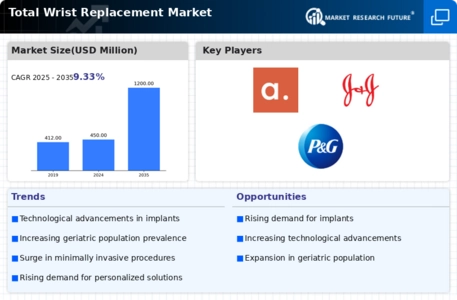Aging Population
The aging population is a critical driver for the Total Wrist Replacement Market. As individuals age, they often experience degenerative joint diseases, including osteoarthritis and rheumatoid arthritis, which can lead to severe wrist pain and dysfunction. According to demographic data, the proportion of individuals aged 65 and older is projected to increase significantly, leading to a higher demand for orthopedic procedures, including total wrist replacements. This demographic shift suggests that healthcare systems will need to adapt to the growing number of elderly patients requiring surgical interventions. Furthermore, the increasing life expectancy means that more individuals will seek solutions to maintain their quality of life, thereby propelling the Total Wrist Replacement Market forward.
Technological Advancements
Technological advancements in surgical techniques and implant design are transforming the Total Wrist Replacement Market. Innovations such as computer-assisted surgery and robotic-assisted procedures enhance precision and reduce recovery times. Additionally, the development of new biomaterials, which offer improved biocompatibility and durability, is likely to increase the longevity of wrist implants. Market data indicates that the adoption of these advanced technologies is on the rise, with a notable increase in the number of procedures performed annually. As surgeons become more proficient with these technologies, patient outcomes are expected to improve, further driving demand for total wrist replacements.
Increased Healthcare Expenditure
Increased healthcare expenditure is a notable driver for the Total Wrist Replacement Market. As countries invest more in healthcare infrastructure and services, access to advanced surgical procedures improves. This trend is particularly evident in regions where healthcare reforms are underway, leading to enhanced coverage for orthopedic surgeries. Market analysis shows that higher healthcare spending correlates with an increase in elective surgeries, including total wrist replacements. Patients are more likely to seek surgical solutions when financial barriers are reduced, thereby expanding the market for wrist replacement procedures. This trend is expected to continue as healthcare systems evolve.
Rising Incidence of Wrist Injuries
The rising incidence of wrist injuries, particularly among athletes and active individuals, serves as a significant driver for the Total Wrist Replacement Market. Sports-related injuries, falls, and accidents contribute to a growing number of cases requiring surgical intervention. Data suggests that wrist fractures and ligament injuries are becoming increasingly common, necessitating effective treatment options. As awareness of the benefits of total wrist replacement grows, more patients are likely to opt for this procedure to regain functionality and alleviate pain. This trend indicates a potential increase in market demand as healthcare providers respond to the needs of this demographic.
Growing Awareness of Treatment Options
Growing awareness of treatment options among patients and healthcare providers is influencing the Total Wrist Replacement Market. Educational initiatives and improved access to information have empowered patients to seek surgical solutions for chronic wrist pain. As individuals become more informed about the benefits and risks associated with total wrist replacement, they are more likely to pursue this option. Additionally, healthcare providers are increasingly recognizing the importance of discussing surgical alternatives with patients. This heightened awareness is likely to lead to an increase in the number of procedures performed, thereby driving growth in the Total Wrist Replacement Market.

















Leave a Comment